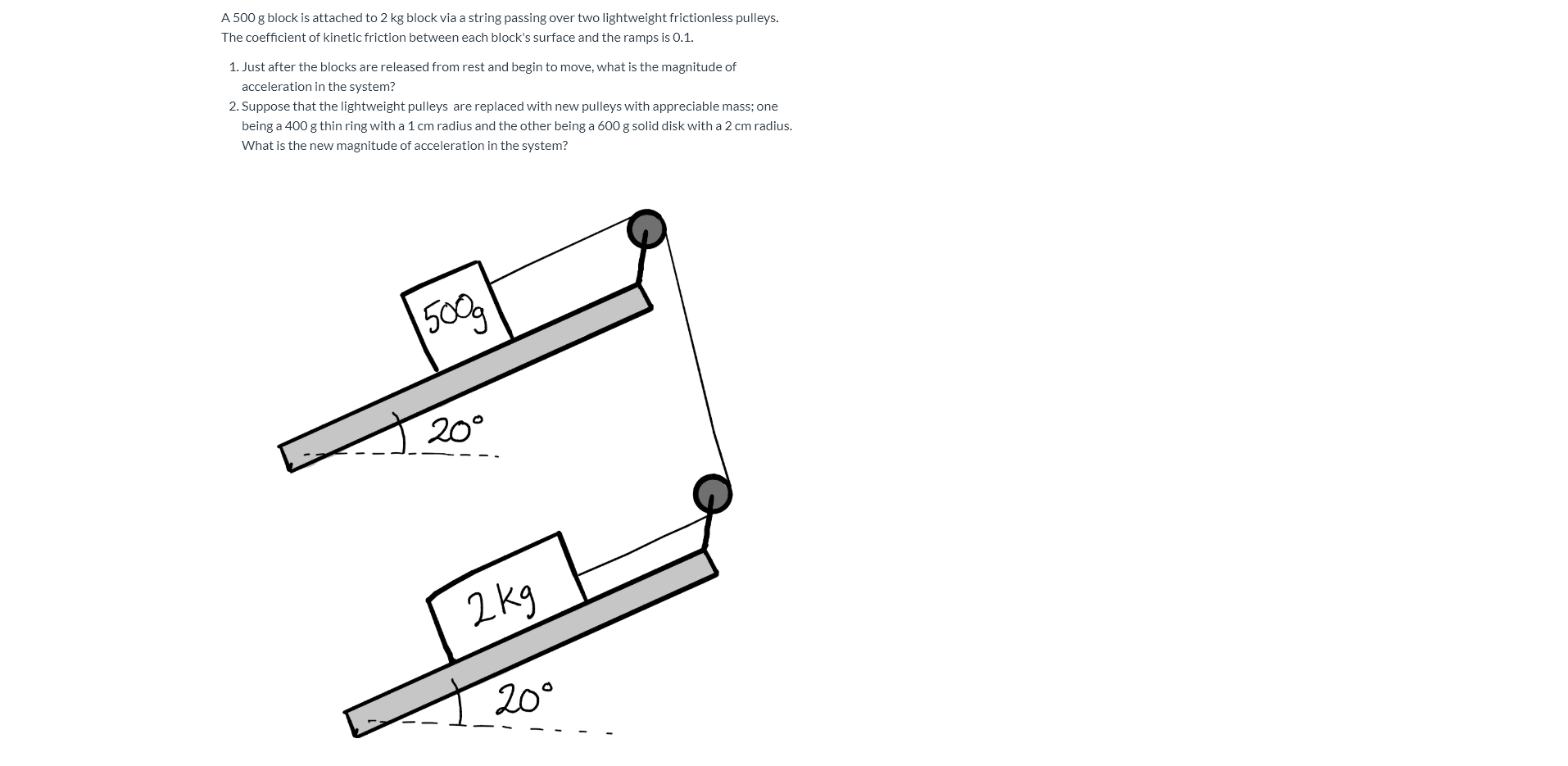A 500 g block is attached to 2 kg block via a string passing over two lightweight frictionless pulleys. The coefficient of kinetic friction between each block's surface and the ramps is 0.1. 1. Just after the blocks are released from rest and begin to move, what is the magnitude of acceleration in the system? 2. Suppose that the lightweight pulleys are replaced with new pulleys with appreciable mass; one being a 400 g thin ring with a 1 cm radius and the other being a 600g solid disk with a 2 cm radius. What is the new magnitude of acceleration in the system? 50g 20° 2kg 20°
A 500 g block is attached to 2 kg block via a string passing over two lightweight frictionless pulleys. The coefficient of kinetic friction between each block's surface and the ramps is 0.1. 1. Just after the blocks are released from rest and begin to move, what is the magnitude of acceleration in the system? 2. Suppose that the lightweight pulleys are replaced with new pulleys with appreciable mass; one being a 400 g thin ring with a 1 cm radius and the other being a 600g solid disk with a 2 cm radius. What is the new magnitude of acceleration in the system? 50g 20° 2kg 20°
International Edition---engineering Mechanics: Statics, 4th Edition
4th Edition
ISBN:9781305501607
Author:Andrew Pytel And Jaan Kiusalaas
Publisher:Andrew Pytel And Jaan Kiusalaas
Chapter7: Dry Friction
Section: Chapter Questions
Problem 7.48P: Find the smallest distance d for which the hook will remain at rest when acted on by the force P....
Related questions
Question
Q 3

Transcribed Image Text:A 500 g block is attached to 2 kg block via a string passing over two lightweight frictionless pulleys.
The coefficient of kinetic friction between each block's surface and the ramps is 0.1.
1. Just after the blocks are released from rest and begin to move, what is the magnitude of
acceleration in the system?
2. Suppose that the lightweight pulleys are replaced with new pulleys with appreciable mass; one
being a 400 g thin ring with a 1 cm radius and the other being a 600g solid disk with a 2 cm radius.
What is the new magnitude of acceleration in the system?
50g
20°
2kg
20°
Expert Solution
This question has been solved!
Explore an expertly crafted, step-by-step solution for a thorough understanding of key concepts.
This is a popular solution!
Trending now
This is a popular solution!
Step by step
Solved in 4 steps with 6 images

Knowledge Booster
Learn more about
Need a deep-dive on the concept behind this application? Look no further. Learn more about this topic, mechanical-engineering and related others by exploring similar questions and additional content below.Recommended textbooks for you

International Edition---engineering Mechanics: St…
Mechanical Engineering
ISBN:
9781305501607
Author:
Andrew Pytel And Jaan Kiusalaas
Publisher:
CENGAGE L

International Edition---engineering Mechanics: St…
Mechanical Engineering
ISBN:
9781305501607
Author:
Andrew Pytel And Jaan Kiusalaas
Publisher:
CENGAGE L